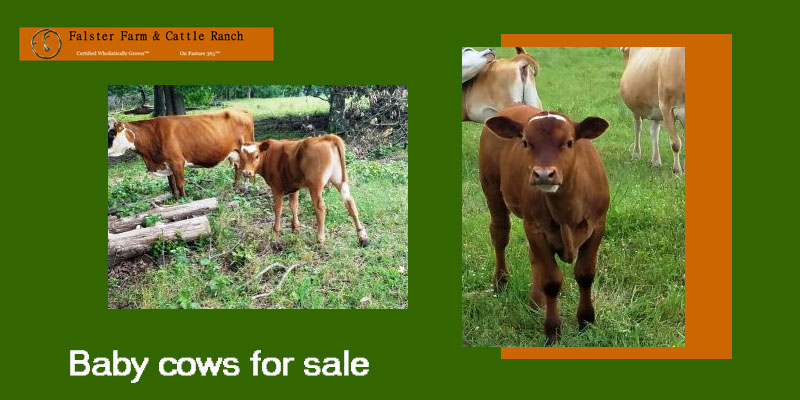
Before looking for baby cows for sale, know that there is no single optimum method for raising calves. What works across one farm might not even work on another. However, you should establish & implement a neonatal procedure as well as a calf treatment plan that is constant from the day in & day out. Cattle disease & mortality rates might be significantly reduced with proper management.
Raising healthy calves is impossible due to inadequate facilities & poor animal care. Recognizing this & knowing calf growth, health, nutrition, & behavior will help you care for your calves successfully.
If you are looking for baby cows for sale, opt for Falster Farm today.
The following calf-raising techniques can be used:
- To boost calf survival rates
- To enhance calf health
- To reduce calves’ exposure to illness
- To boost growth rates
Calf Growth
Before looking for baby cows for sale, you must first get some ideas about calf growth. Calf-raising success may be measured using both survival & growth rates. Dairy replacement rates of growth eventually influence puberty time. However, this has an impact on the age of initial freshening as well as lactation milk output.
Calves that have been properly reared will be healthy & ready to replenish between the ages of 22 & 24 months.
1-Keeping track of calf development
Before searching for baby cows for sale, know that a disease might reduce a calf’s development rate & cause persistent issues that prevent the youngster from attaining its full genetic potential. Calves that have healed from sickness will most likely be weeks or months behind their healthy herd mates. If their condition was serious or long-term, lasting damage or persistent suffering might cause these animals to become economic hazards.
Breed-specific heifer goal growth curves are offered.
- Measure and record the heart circumference and ghast height in inches.
- Weigh the calves using a scale or a standard tape measure.
- Measure your height using a ruler or an altimeter stick with a parallel level bar.
- Determine the following for each baby calf: ADG (Average daily gain), percentage of weight-growth objective & the group’s averages
- Graph the number of baby calves with weights that are above or below the ideal for their age. You may use computer software to assist you with this.
Preventing Disease
1-Recognizing & Managing Stressors
Calves can be stressed by changes in routine. When animals are agitated, they are more prone to develop ill. Changes in feed, housing, & crowding can all stress calves & produce stomach problems, including scours.
Other stresses include:
- Transporting
- Ear tagging
- Improper calves handling
- Disbudding/Dehorning
2-Biosecurity
Before opting for baby cows for sale, have a biosecurity program in place. All cattle, equipment, & personnel entering your calf facility must be controlled & monitored. In order to develop your illness preventive & treatment program, consult with your local veterinarian.
Calves are being monitored:
- Use a rectal temperature gauge on a regular basis to aid in the detection of early fever in ill calves. Calves have a typical body temperature of 101.5 degrees Fahrenheit.
- Separate the calves, so they do not come into physical touch with each other. This allows you to monitor calves individually throughout the critical pre-weaning time. Alternatively, if they are group housed before weaning, keep a constant eye on them.
Extra biosecurity precautions for you to take a look at before opting for baby cows for sale:
- Evaluate your vaccination program on a regular basis, but don’t rely solely on immunizations to solve illness concerns.
- It helps control infection sources, particularly feces. Water, feeding utensils, birds, rats, pets, & humans can all be sources of illness.
- Instead of placing the calf in bedding, place it on a clean plastic sheet.
- After a heifer is born, use clean towels to massage it dry. Use no bedding or feed sacks. Wipe the mucous from the nose.
- Always separate calves as soon as possible from the cow, feces, & urine.
- When conducting chores, start with the youngest animals & work your way up.
- Isolate ill calves, feed them last, & handle them in the end.
- Use distinct maternity enclosures that are sanitized between calvings. Moreover, this includes eliminating prior birth bedding, dung, & other materials. Pathogens are introduced into the maternity pen with each cow.
- Stop the spread of Johne’s disease. When calves consume infected excrement or colostrums, they get Johne’s illness. Disease risk might be minimized by properly handling newborn calves.
- Between calves, wash, disinfect, & dry specific hutches, stalls, or enclosures. Scratch the ground to a new level of soil and eliminate any remaining organic matter.
Calf feeding practices
Following the birth of a baby calf:
- Clean the cow’s mammary glands before the calf nurses, or simply withdraw the calf from the mother and maternity area.
- Feed high-quality colostrum to calves as soon as feasible.
Every day, provide new, clean calf colostrum, milk replacer, & water. Make sure to provide water at least twice a day. To prevent urine & manure contamination, place these outside the enclosure. Spilled liquified feed & water will also be kept away from the calf’s bedding.
Ensure that the calves’ food (liquified feed, grass, & grain) is of excellent quality throughout the preweaning stage. According to research, inadequate nutrition between weaning & six months of age might result in these animals having:
- A four & half month delay in age upon first calving
- Reduced growth rate
- Increased chance of being culled as a cow
Housing
Calf housing must be fully isolated from the dairy production house barn, with its own ventilation. To keep flies at bay, keep air inlets and windows covered at all times.
Bedding
Before opting for baby cows for sale, know that calf comfort is greatly influenced by bedding. It is critical to manage bedding throughout the early stages of preweaning. A large, dry bed of puffy material can:
- assist calves in staying clean
- Lower the chance of illness
- Provide a comfortable resting area
- Serve as a moisture-absorbing medium
- Reducing stress
Conclusion:
Calves have unique care requirements that must be met in order for them to reach adulthood in excellent health & comfort. We hope you will have no additional problems now that you know how to care for a young cow.
Call to Action:
Well, if you are looking for baby calves, opt for Falster Farm’s services today. Our guaranteed present to you is quality, service, & a low price for a wide variety of genuine organic country foods, breeding services, mini cattle, & even educative stays & events. For more info, call 903-629-3034.








